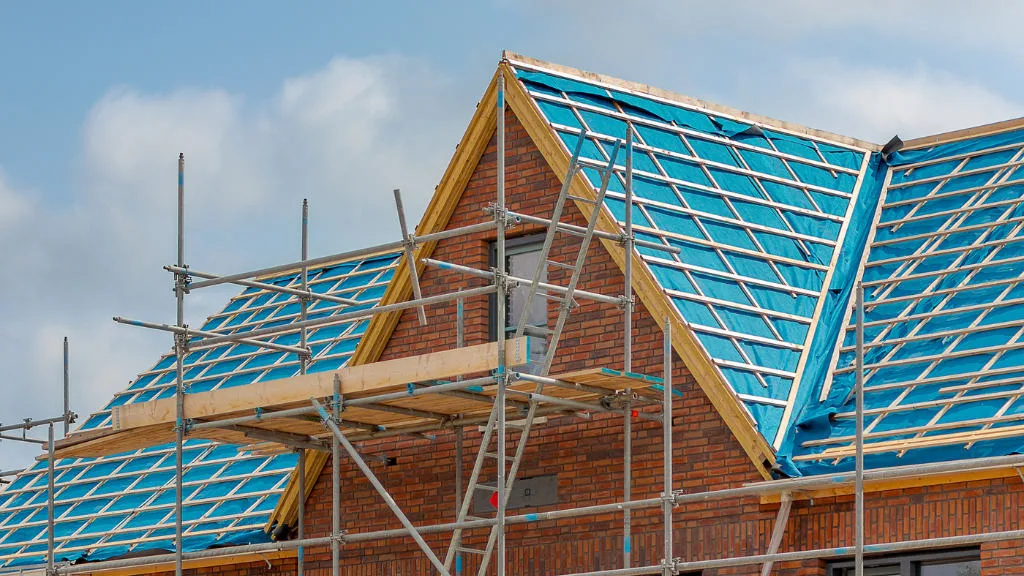
Oftentimes, what we don’t realize is that a roof not only shields us from the rain and snow but it also protects our home. Unfortunately, roofs can wear down over time and may need to be replaced entirely.
If your home’s roof has been in place for 15 years or more, you’re probably going to want to change it out before it gets worse.
The pitch of your roof is one of the most important aspects to consider when remodeling or building a new home.
The slope of your roof can affect different parts of your house and has several different purposes, but we will focus on three reasons to change the pitch: aesthetics, energy efficiency, and water run-off.
The three most typical reasons for a roof’s pitch to need changing are as follows:
Aesthetics
Changing the pitch of your roof can also change how your home looks, which is why many people choose to remodel their homes or add a new room.
One example would be if you have an attached garage and wish to put in another bedroom on top instead of adding an addition for it.
Energy Efficiency
Another reason to change the pitch is because it can affect how well your home retains heat.
If you have a flat roof, this means that there will be more surface area exposed and so the house may lose its warmth quicker than if it had a slanted one.
It’s important to consider energy efficiency when choosing what kind of roofing materials you use as well.
Water Runoff
Last but not least, changing the pitch of your roof can also affect how well it protects against rain and snowfall.
For example, if you have a flat or low-pitched roof then water might accumulate instead of flowing down properly – this could cause leaks and other damage to your home’s interior that may go unnoticed and cause even more damage.
How to Determine Whether Your Roof’s PITCH Needs to Change
There are a few ways that you can tell whether your roof needs to change pitch.
- The pitch of your roof may need to change if you live in an area that gets extreme weather conditions like heavy winds and rain.
- This is because a low pitch can increase the risk of flooding damage on your home’s foundation, while a high pitch will be more likely to withstand such circumstances.
- You might also want to consider changing the pitch of your roof if you want to change how high it is.
- For example, if you already have a flat roof and would like to make it lower or vice versa, then changing the pitch will be necessary in order for this idea to work out.
- Another reason that might prompt you to consider changing pitch is because there are simply more benefits to it.
- For example, one benefit is that changing the pitch of your roof can also affect how well your home retains heat during wintertime.
- If you have a flat or low-pitched roof then this means that there will be more surface area exposed and so your house may lose its warmth quicker than if it had a slanted one.
- The pitch of your roof can also affect how well it protects against rain and snowfall.
- For example, if you have a flat or low-pitched roof then water might accumulate instead of flowing down properly – this could cause leaks and other damage to your home’s interior that may go unnoticed and cause even more damage.
If you know that your roof already needs changing, then be sure to contact an expert so you can make the best decision for yourself.

What Are the Different Types of Pitched Roofs?
The different types of pitched roofs can be broken down into four major categories.
Flat Roof
Flat roofs are probably the easiest to identify. They have a very low pitch and usually only experience problems when they get old or if there is heavy rain/snowfall happening at their location.
Flat roofs are more common for homes with detached garages because it can be convenient to make room for one on top of the house’s structure.
Slanted roof
Slanted roofs are the opposite of flat ones in that they have a much higher pitch and may need to be changed depending on your geographical location.
Slanted roofs can sometimes experience issues with water run-off if it’s raining hard, so you might want to consider changing them if this is happening too often at certain times of year.
Gable roof
Gable roofs are the most recognizable with their two opposing slopes that create an “X” shape. They’re often found on houses within North America, but they can be changed depending on your needs and location as well.

Hip roof
Hip roofs have four sides instead of just two like gabled ones do – this makes them more complex to construct which means they’re usually more expensive to change.
They often end up having a much steeper slope than gable roofs or even flat ones, which can make them very effective in areas where there is heavy rain/snowfall throughout the winter season.
How to Change Your Roof’s Pitch
Once you know it is time to change the pitch of your roof, then there are a few different ways in which this can take place:
Pitch Replacement
With pitch replacement, you will be removing the old roof and installing a new one with its own pitch.
In this case, it is crucial to be sure that your house’s structure can handle such changes – otherwise there could be major problems like leaks or even collapses if things aren’t well-maintained and up-kept.
Pitch Adjustment by Adding or Removing Shingles
With pitch adjustments, you can change the roof’s slope without having to remove all of the old ones.
It is a good option if you don’t want to go through such drastic changes and would like something that allows for more flexibility in case you ever need repairs done on your home’s roof later on.
Roof Pitch With Adjustable Trusses
Adjustable trusses are one of the best options for adjusting your home’s roof because you can do so by simply making adjustments to them yourself without having to go through too much hassle or expense.
With their help, it is possible not just to change but also maintain and repair your roof’s pitch throughout the years.
Roof Pitch Calculator
If you want to change or maintain a certain slope for your home, then it might be helpful to have access to some kind of Roof Pitch Calculator that can help give you an accurate readout about how much work will need to go into such changes and what their costs would be.
It’s important to consider other factors so that you should be able to determine whether or not your home’s roof needs changing based on its pitch and what options are available if so.
If it is time for a change, then hopefully one of these methods will help you make such changes easier and more affordable than before!
Tips on How to Keep a Roof’s Pitch in Good Shape From the Beginning Include:
- Choosing roofing materials that are durable, long lasting and energy efficient.
- Keeping trees away from the edges of your home’s foundation to avoid damage during strong wind storms or heavy rains.
- Making sure gutters and downspouts work properly so water is carried off in a timely fashion – this can help prevent leaks as well.
- Inspecting your roof regularly for any issues that need to be repaired.
Maintaining your roof is essential for keeping it in good condition and with the right pitch.
In the end, it is important to remember that there are a lot of reasons why you need to change the pitch of your roof and understand the importance of changing it when needed.
Maintaining your roof is one way you can avoid damages and ensure the longevity of your home. We hope this blog helps you with any questions or concerns about understanding how roofs work and what kind of maintenance they require in order for them to last a lifetime!

